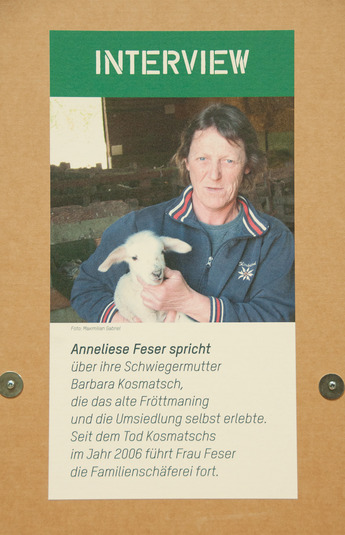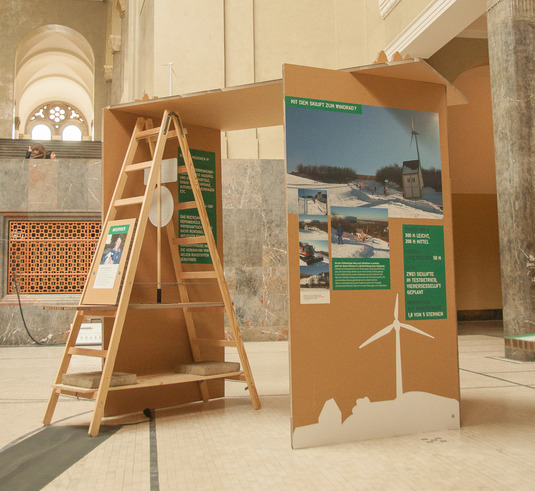Ecopolis Munich Exhibition/Fröttmaninger Müllberg
Can One Simply Bury the Past?
14.09.2017
This project by Katharina Ring and Maximilian Gabriel, students of the RCC-LMU Environmental Studies Certificate Program, stems from research conducted as part of the exhibition project “Ecopolis: Understanding and Imagining Munich’s Environments.”
The Fröttmaninger Müllberg. Photo Credit: Maximilian Gabriel.
Near the Allianz Arena, directly next to the highway and the sewage treatment plant,
one might expect to find a vacant lot—surely not a recreational area?
But the Fröttmaninger Müllberg—a mountain made from waste—
is supposed to be exactly that.
From 1954 to 1987, Munich’s household waste was dumped here.
Since then, the city has put a lot of effort into transforming this blemish
into a natural, green paradise—but has it been successful?
The environmental restoration project has ended,
but only intensive maintenance will ensure long-term balance.
In 1999, the city of Munich built its first and only wind turbine on top of the hill,
as if to give Munich and the Müllberg a greener image.
But we wonder if the past will resurface?
A Mountain of Waste Arises
During the first half of the twentieth century
Munich had an advanced waste disposal system.
But the Second World War left its mark:
after the central garbage plant was destroyed in 1944,
ditches and pits in the city and on its outskirts served as dumps.
The people grew discontented.
The city finally offered an alternative with the construction of a new
recycling plant in the north of Munich in 1954—even if it was 10 years later.
However, the village of Fröttmaning and its old church had to make way
for the plant’s incineration residue to be stored.
Soon after came economic recovery and consumerism—
the amount of waste to exploded, inducing a garbage crisis.
The new plant could no longer cope with the flood of waste.
Unsorted household trash was added to the incineration residue
and, with time, grew into an imposing mountain of garbage.
The stench and toxins contaminated both air and water.
In 1973, 10 years before the landfill was shut down,
Munich’s Department of Urban Landscaping
decided to transform the mountain of waste into a recreational area.
Today, a reconstruction of the Fröttmaninger Church commemorates the village of Fröttmaning and is located
not far from its original location—half sunk in the mountain.
"Danger, Landfill Gas". Photo Credit: Maximilian Gabriel.
Facts about Garbage(mountain)
Amount of waste: Around 12 million m³
Contents: Initially incineration residue, later household and commercial waste, including refrigerators, car tires, chemicals, etc.
Period the landfill was active: 1954–1987
Resource potential: The recycling of landfill waste is not yet economically viable. The most recent technologies and current commodity prices make the extraction of new raw materials more favorable.
Traveling to the Wind Turbine by Lift
The Skiarena Association is planning to establish a skiing area
to make the Fröttmaninger Mountain more attractive in the future.
Numerous ski cannons and groomers will ensure that, even without real snow,
a one-minute descent is possible.
In 2008, the first test operation took place on the premises.
But unstable surfaces make it difficult to secure the lifts,
and snowmaking is a danger to highway traffic.
As a result, at least for the time being, the project has been
put on hold and the city of Munich has withdrawn from the plan.
Facts about the Skiing Area
Slopes: 500 m (300 m easy, 200 m medium)
Difference in altitude: 50 m
Lifts: Two rope lifts in trial operation; One four-chair lift planned
Rating on Skiresort.de: 1.8 out of 5 Stars

Mrs Feser with one of her sheep. Photo Credit: Florin Pruna.
A Shepherdess Remains Steadfast
Four local families had to leave their homes by 1954
when the decision was made to build a landfill in Fröttmaning
Yet Barbara Kosmatsch defied the city’s plans.
She persisted until 1985—all while, the garbage grew around her.
Her daughter-in-law speaks about her unshakeable sense of
home and tradition, which you can hear at the listening station [in German].
It Is Forbidden to Light Candles in Munich’s Oldest Church
Highly flammable methane leaks out of the hill.
That is why open flames are prohibited on and near the old landfill,
and why no candles may be lit at the Heilig-Kreuz-Kirche.
A process of fermentation in the hill produces the gas.
The haphazard storage of garbage that prevailed until the 1980s
has made it difficult to seal the dump reliably today.
This means toxins can contaminate the groundwater,
making it necessary to test the surrounding areas continuously.

The Fröttmaninger Müllberg during the Ecopolis Exhibition. Photo Credit: Florin Pruna.

